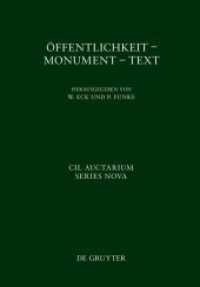- ホーム
- > 洋書
- > 英文書
- > History / World
Full Description
Miniature and fragmentary objects are both eye-catching and yet easily dismissed. Tiny scale entices users with visions of Lilliputian worlds. The ambiguity of fragments intrigues us, offering tactile reminders of reality's transience. Yet, the standard scholarly approach to such objects has been to see them as secondary, incomplete things, whose principal purpose was to refer to a complete and often life-size whole.
The Tiny and the Fragmented offers a series of fresh perspectives on the familiar concepts of the tiny and the fragmented. Written by a prestigious group of internationally-acclaimed scholars, the volume presents a remarkable diversity of case studies that range from Neolithic Europe to pre-Colombian Honduras to the classical Mediterranean and ancient Near East. Each scholar takes a different approach to issues of miniaturization and fragmentation but is united in considering the little and broken things of the past as objects in their own right. Whether a life-size or whole thing is made in a scaled-down form, deliberately broken as part of its use, or only considered successful in the eyes of ancient users if it shows some signs of wear, it challenges our expectations of representation and wholeness, of what it means for a work of art to be "finished" and "affective." Overall, The Tiny and the Fragmented demands a reconsideration of the social and contextual nature of miniaturization, fragmentation, and incompleteness, making the case that it was because of, rather than in spite of, their small or partial state that these objects were valued parts of the personal and social worlds they inhabited.
Contents
Contributors to the Volume
Chapter 1: In/Complete: An Introduction to the Theories of Miniaturization and Fragmentation
S. Rebecca Martin and Stephanie Langin-Hooper
Chapter 2: Breaking Bodies and Biographies: Figurines of the Playa de los Muertos Tradition
Rosemary Joyce
Chapter 3: Tiny and Fragmented Votive Offerings from Classical Antiquity
Jessica Faye Hughes
Chapter 4: Divinity In Part or In Full? Representations of Tanit in Texts and Art
S. Rebecca Martin
Chapter 5: Style as a Fragment of the Ancient World
Marian H. Feldman
Chapter 6: Stronger at the Broken Places: Affect in Hellenistic Babylonian Miniatures with Separately-Made and Attached Limbs
Stephanie Langin-Hooper
Chapter 7: Tiny Bodies for Intimate Worlds. Human Figurines in Iberian Iron Age Sanctuaries
Mireia López-Bertran and Jaime Vives-Ferrándiz
Chapter 8: Incomplete: The Uneasy Powers of Holes, Cut Surfaces, and Neolithic Pit-Houses
Doug Bailey
Chapter 9: A Response: Scaling the Walls of Persepolis toward an Imaginal Social/Material Landscape
Margaret Cool Root
Index








